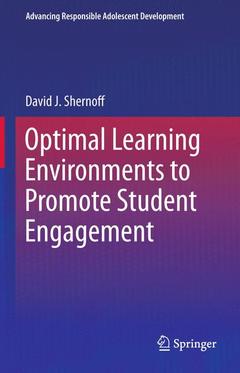Description
Optimal Learning Environments to Promote Student Engagement, 2013
Advancing Responsible Adolescent Development Series
Author: Shernoff David J.
Language: English
Subjects for Optimal Learning Environments to Promote Student Engagement:
Keywords
Academic achievement and student engagement; Achievement gap and student engagement; Alienation and disengagement; Belongingness and engagement; Child engagement and disengagement; Emotional development and positive psychology; Emotional regulation and student engagement; Engagement and disengagement at school; Experience Sampling Method (ESM); Flow Theory and Csikszentmihalyi; Learning environments and student engagement; Mentoring and group engagement; Montessori and alternative public schools; Optimal learning environments; Positive psychology and youth development; Positive youth development and engagement; School violence and student disengagement; Self-regulation and child development; Youth engagement and disengagement
158.24 €
Subject to availability at the publisher.
Add to cartSupport: Print on demand
368 p. · 15.5x23.5 cm · Hardback
Description
/li>Contents
/li>Biography
/li>Comment
/li>
Optimal Learning Environments to Promote Student Engagement analyzes the psychological, social, and academic phenomena comprising engagement, framing it as critical to learning and development. Drawing on positive psychology, flow studies, and theories of motivation, the book conceptualizes engagement as a learning experience, explaining how it occurs (or not) and how schools can adapt to maximize it among adolescents. Examples of empirically supported environments promoting engagement are provided, representing alternative high schools, Montessori schools, and extracurricular programs. The book identifies key innovations including community-school partnerships, technology-supported learning, and the potential for engaging learning opportunities during an expanded school day. Among the topics covered:
- Engagement as a primary framework for understanding educational and motivational outcomes.
- Measuring the malleability, complexity, multidimensionality, and sources of engagement.
- The relationship between engagement and achievement.
- Supporting and challenging: the instructor?s role in promoting engagement.
- Engagement within and beyond core academic subjects.
- Technological innovations on the engagement horizon.
Optimal Learning Environments to Promote Student Engagement is an essential resource for researchers, professionals, and graduate students in child and school psychology; social work; educational psychology; positivepsychology; family studies; and teaching/teacher education.
1. Introduction: Towards Optimal Learning Environments in Schools.- 2. Aims of Education Revisited (Einstein’s E = MC2 of Education).- 3. The Nature Engagement in Schools.- 4. Measuring Student Engagement in High School Classrooms and What We Have.- 5. Engagement as an Individual Trait and its Relationship to Achievement.- 6. Connecting to “The How” of Classroom Engagement: Instruction and Optimal.- 7. Connecting to “The Who”: The Primacy of Supportive.- 8. Connecting to “The What”: Engaging Approaches to Traditional Subject Matter.- 9. Engagement Beyond the Core Academic Subjects.- 10. Private School Models and The Case of Montessori Schools.- 11. Alternative Public School Models.- 12. Learning from Research on Youth Engagement During Out-of-School Time.- 13. Model After-School Programs.- 14. Technological Innovations on the Horizon.- 15. Re-engineering the Schools of Tomorrow: Towards Community Sponsorship.
David J. Shernoff, Ph.D., is an associate professor of educational psychology at Northern Illinois University and visiting associate professor at Rutgers University. He received his doctorate in education from the University of Chicago in 2001. His dissertation work applied Mihaly Csikszentmihalyi’s theory of flow and experience sampling methodology to the examination of student engagement in high school. From 2001-2003 he served a postdoctoral fellowship at the University of Wisconsin-Madison where he co-managed a grant-funded research project on middle school students’ engagement in school-based after-school programs. While at Northern Illinois University, he has taught courses on adolescent development, educational psychology, and motivation in the classroom to graduate and undergraduate students. His research interests include student motivation and engaging learning environments, engagement in educational video games, and mentoring. His grant-funded empirical work and journal articles related to the topic of engagement have focused on, a) contextual, student, and school influences on student engagement in high school, and the effects of student engagement on short-term and long-term outcomes; b) the influence of school-based after-school programs on middle-school students’ engagement, engaging and disengaging after-school program activities, and engagement in after school programs as a predictor and mediator of social and academic outcomes; c) the impact of a video-game approach to mechanical engineering education on student engagement and learning, and d) the impact of teacher behaviors and the motivational dimensions of the learning environment on student engagement in high school classrooms. His other book titles include Good Mentoring (Jossey-Bass, 2009, with Jeanne Nakamura), The Individual-Maker (William & Sons, 2001), and the forthcoming volume, Engaging Youth in Schools: Evidence-based Models to Guide FutureInnovations




